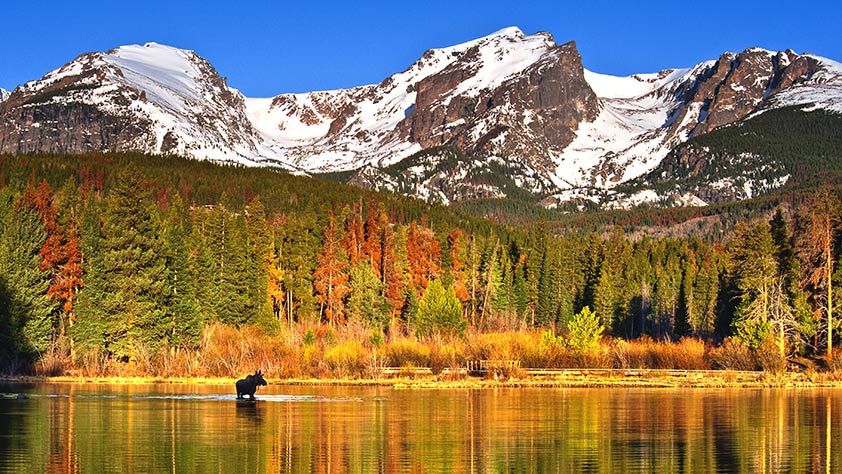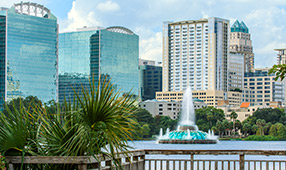New England is well-known as a leaf-peepers’ haven but if you’re not on the East Coast, there are many locations west of the Mississippi River that will also astound you with spectacular fall color. One of these fall foliage regions in the West may be near enough for a weekend jaunt.
California
Amazing spectacles of leaves changing color can be found in Sequoia and Kings Canyon National Parks on the southern slopes of the Sierra Nevada Mountains east of San Joaquin Valley. Look for a rainbow of dogwoods, black oaks, aspen and black cottonwood. Fall color starts in August at about 10,000 feet and drops by elevation at a rate of 500 to 1,000 feet a week for 3 months.
Some of the best color in the Tahoe area can be found along Highway 89 from South Lake Tahoe to Ed Z’berg Sugar Pine Point State Park. Another standout is Humboldt Redwoods State Park, south of Eureka on Highway 101, which has big leaf maples, Oregon ash, dogwoods, black oaks, red alder, white alder and cottonwood.
Missouri
Trees such as birch, maple, sycamore, cottonwood and sassafras provide a brilliant panorama in autumn. Red and purple colors peak in mid-October when sugars made during warm days are trapped in the leaves during cool nights. This is when maples, ashes, oaks and hickories are at the height of their color display.
Color change starts in north Missouri and moves southward across the state, lasting 4 to 6 weeks. Sassafras, sumac and Virginia creeper change early, beginning in mid-September. By late September, black gum, bittersweet and dogwood are turning.
And don’t miss fall in the Ozarks, an explosion of color for which you can get free driving maps at the Branson Welcome Center at U.S. 65 and State Highway 248.
Wisconsin
Take in the leafy show in the Wisconsin Dells by boat, zip line or horseback. Start exploring in Sheboygan County, where more than 30,000 acres of forest provide dazzling color. Check out Kettle Moraine State Forest and other state parks for a wealth of fall color viewing opportunities. Because many Wisconsin state forests were formed around watersheds, visitors can admire a panorama of fall colors while enjoying recreation opportunities along lakes, rivers and streams.
Notable drives for fall color include Lake Superior Scenic Drive, Upper Peninsula and Black River Scenic Byway (with colorful Black River waterfalls as a bonus). Drive on U.S. Highway 2 from Ashland to Amnion Falls State Park about 15 miles east of Superior, Wisconsin.
Click here for fall color updates and maps.
Colorado
Aspens, the quintessential Colorado tree in the Rocky Mountain area, glisten gold and red when the temperature starts to drop. Maroon Bells, two towering 14,000-foot mountains southwest of the aptly named town of Aspen, are quite possibly the most photographed mountains in North America. No wonder: The peaks are an ideal spot to capture the glory of fall color.
Trail Ridge Road, which winds through Rocky Mountain National Park from the town of Estes Park in the east to Grand Lake in the west, provides an amazing vantage point for leaf peepers whose journey is never complete without dozens of photos.
Other Colorado leaf destinations include Gunnison, home to Keebler Pass where the largest aspen grove in North America is located. San Juan Skyway, a breathtaking 236-mile loop through the San Juan Mountains of southwest Colorado, offers visitors an amazing array of fall colors. The Telluride Free Gondola is one of the most popular ways to view amazing fall colors. The aerial views include the town of Telluride, its box canyon and colorful valleys lined with aspens and evergreens.
Texas
State parks offer some of the best places to view spectacular fall foliage. You can see autumn’s display of dazzling color like the legendary Bigtooth maple trees at Lost Maples State Natural Area in the Hill Country. Lost Maples is an area of Bigtooth maples that have grown there, alone and separate from all of the other maples in the world.
Shades of red and gold of sweet gum and oak in the piney woods of East Texas provide a glorious fall spectacle. Lofty cottonwoods that turn a brilliant yellow at Caprock Canyons and Palo Duron Canyon state parks in the Panhandle and in Davis Mountains State Park in far West Texas add to the unexpected palette of color in the Lone Star state.
Along Ranch Road 1050 west of Utopia to U.S. Highway 83, look for bright red sumacs, blazing yellow cottonwoods and orange and yellow sycamores. Along the Guadalupe River you’ll see cypress trees in glowing orange.
The drive from Camp Wood to Leakey, often called the “most scenic” drive in Texas, is an excellent trail for fall color. Roadside lookouts offer great vistas of reds, greens, yellows and golds.
Bookmark these additional trip-planning resources
- California: California Fall Color
- Missouri: Missouri State Parks
- Wisconsin: Wisconsin Fall Color Report and Viewing Opportunities
- Colorado: 10 Places to See Colorado’s Fall Color
- Texas: East Texas Fall Foliage Road Trip Ideas












